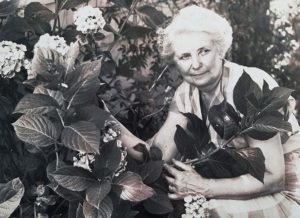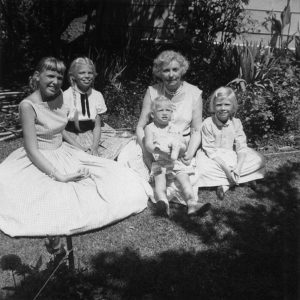Aug. 27 Column: Kids in the Garden

I have to tell you that writing today’s column was such a pleasure for me! In it, I recalled my early exposure to gardening. That came from my Grandmother (shown at left), my Mom, and my oldest sister. Here is a link to it, in today’s edition of The Spokesman-Review. A love of gardening is a legacy worth passing from one generation to the next. (or you can read my column lower in this post)
What’s the take-home message? The importance of involving kids in the garden. It’s a skill and a passion that will stay with them throughout their lives. I hope you will enjoy it.
Here is photo of my Grandmother and 3 sisters. (L-R: Kathy, Lucy, and Anne on the far right; I’m the toddler in my Grandmother’s lap). The cool thing is that all of my sisters and I are VERY into gardening! Three of us are Master Gardeners, and we’re waiting for Anne to become one… in her “spare time,” ha ha!) I remember our Mom once saying, “I don’t know how I managed to raise a bunch of farmers!”
It’s also time for the next installment of my “Everyone Can Grow A Garden” video series. Today’s topic is on pruning tomatoes. It’s the second of my three videos on how to maximize your tomato harvest before the end of the season.
In retrospect, there is one thing I didn’t emphasize very well in this video. That is how to apply this information to growing in other USDA hardiness zones.
Here in Spokane, Wash., we are in zone 6 (in theory). Although my garden is in its own microclimate of about zone 5. We have the potential to get our first frost around mid-September. My pruning techniques begin about 6 weeks before then.
If your area gets an earlier or later first frost, count 6 weeks prior to your potential frost date. That will give you the correct timing for these 3 pruning sessions.
To use my example, that means I do my first pruning session in early August. The second pruning is in about the 3rd week of August and the final pruning in early September.
Garden column: Kids in the Garden
by Susan Mulvihill
When I was a little girl growing up in Southern California, I spent time every summer at my maternal grandmother’s home. Grandmother Emma lived in Pasadena and became a widow at an early age.
Raising two children alone during the Depression years must have been a challenge for her, but she was very independent and resourceful. A talented seamstress, she made custom draperies, slip covers and clothing for her customers to provide for her young family.
Naturally, I didn’t know her back in those days, but I do know gardening was a passion throughout her life. During my visits, she would take me out to the backyard and show me what she was growing. It didn’t matter to her that I was so young at the time: I learned how she cared for the plants and tasted fresh blackberries for the first time in that delightful garden.
I also remember her taking me by the hand and walking me down Colorado Blvd. to the pet shop, since I was enthralled with tropical fish back in those days. Each time she encountered a friend or neighbor along the way, she would proudly announce “this is my granddaughter!” Those are sweet memories for me.
At the age of 10, I became an aunt for the first time. During my early teen years, I spent time with my oldest sister and her growing family in Spanaway, Wash. In Kathy’s huge garden, I was introduced to the wonders of fresh raspberries, zucchinis and all manner of tasty produce.
One of the best memories I have from those visits was seeing her young kids out in the middle of the garden, snacking on pea pods, cherry tomatoes and strawberries. When they were hungry, that garden was where they headed because they knew from an early age just how wonderful fresh produce was.
By the time I turned 16, I started growing my own vegetable garden. It was mostly comprised of zucchini and tomato plants, but I enjoyed caring for it and felt enormous pride when my harvests were part of our family dinners.
I gardened with my mom for much of those years. She primarily grew flowers but, once again, being out in the garden was an integral part of my upbringing.
All of these memories underscore the importance of involving kids in all aspects of gardening because doing so impacts them positively throughout their lives.
When kids go to the grocery store, they should know how that produce got there. It’s a sad reality that a large percentage of children don’t understand how tomatoes, potatoes and other crops grow.
So here is my request: if you garden, bring your kids and grandkids out there with you. Share the experience of planting seeds, watching them grow and then harvesting the fruits of your labor. Let them delight in the perfection of a huge yellow sunflower, or watch the bees busily gathering pollen from them.
Teach them the importance of insects and the vital roles they play in a healthy garden. Point out the beautiful birds that visit your garden and learn together about what they eat, where they nest and how they care for their young.
If you don’t garden, ask a friend or neighbor who does to teach you how to get started. It’s never too late to become a gardener or to cultivate in a child something that will become a lifelong passion.


